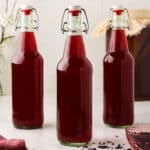
Hibiscus Kombucha
Hibiscus kombucha has tart and floral flavor and a beautiful bright pink color. It boasts benefits from hibiscus tea, and healthy probiotics!This recipe makes about six 16oz bottles.
Servings 12 servings
Calories 56kcal
Ingredients
- 6 tablespoons dried hibiscus flowers
- 6 cups water
- 1/2 cup sugar
- 6 cups fermented kombucha
Instructions
- Put the dried hibiscus flowers and water into a pot and bring to a boil, then remove the pot from the heat.
- Add the sugar to the hibiscus tea and stir to dissolve.
- Let the tea cool completely to room temperature, then strain out the hibiscus flowers with a fine mesh sieve.
- Gently swirl the fermented kombucha (from the first fermentation process) before you pour it into the bottles to evenly distribute the yeast, then pour one cup of brewed kombucha into each bottle.
- Then pour about one cup of hibiscus tea into each bottle, leaving about 1-2 inches in the neck of the bottles for headspace.
- Seal the bottles and shake them gently to mix.
- Place the bottles in a room that is out of direct sunlight, and where you will remember to check on them daily.
- As the fermentation process occurs, you will notice little bubbles forming at the top and the yeasts will float. Check the bottles daily and “burp” them at least once daily to release pressure. If there is built up pressure and bubbles race to the top, then move the bottles to the refrigerator. Depending on the ambient air temperature, this can take anywhere from 2 to 5 days or so.
- Best served chilled on a warm summer day.
Notes
- More or less sugar can be used based on your preference.
- Hibiscus kombucha can be made with black tea or green tea fermented kombucha.
- I like the balance of using half kombucha and half hibiscus tea per bottle, but this can also be adjusted to your liking.
- Hibiscus kombucha will not get as fizzy as fruit kombuchas.
- This kombucha can be chilled and enjoyed right away if you prefer to skip the 2 fermentation process.
- When you burp the bottles to release the pressure, check to see how quickly the bubbles race to the top. If you only see a few bubbles and they are slow to make their way to the top, you can replace the lid and check the next day. If the pressure release is loud and bubbles race to the top, then you know it is time to move that bottle to refrigeration!
- In cooler weather, kombucha takes longer to ferment. In warmer weather, the process goes much faster. I recommend checking your bottles daily until you get familiar with the process and about how long it takes in your situation. Refrigeration slows the process, which will keep the kombucha from exploding under pressure.
Nutrition
Serving: 1cup | Calories: 56kcal